Iron Kingdoms by Azran
Introduction and Lorepost
Original SA post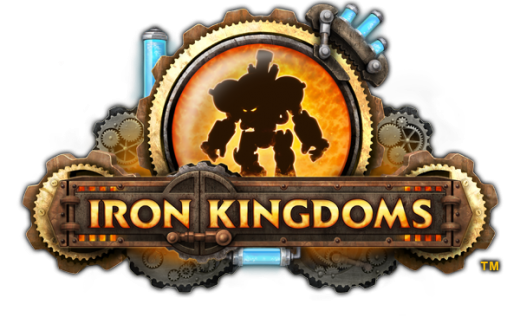
Also known as Robots Punching Things: The RPG
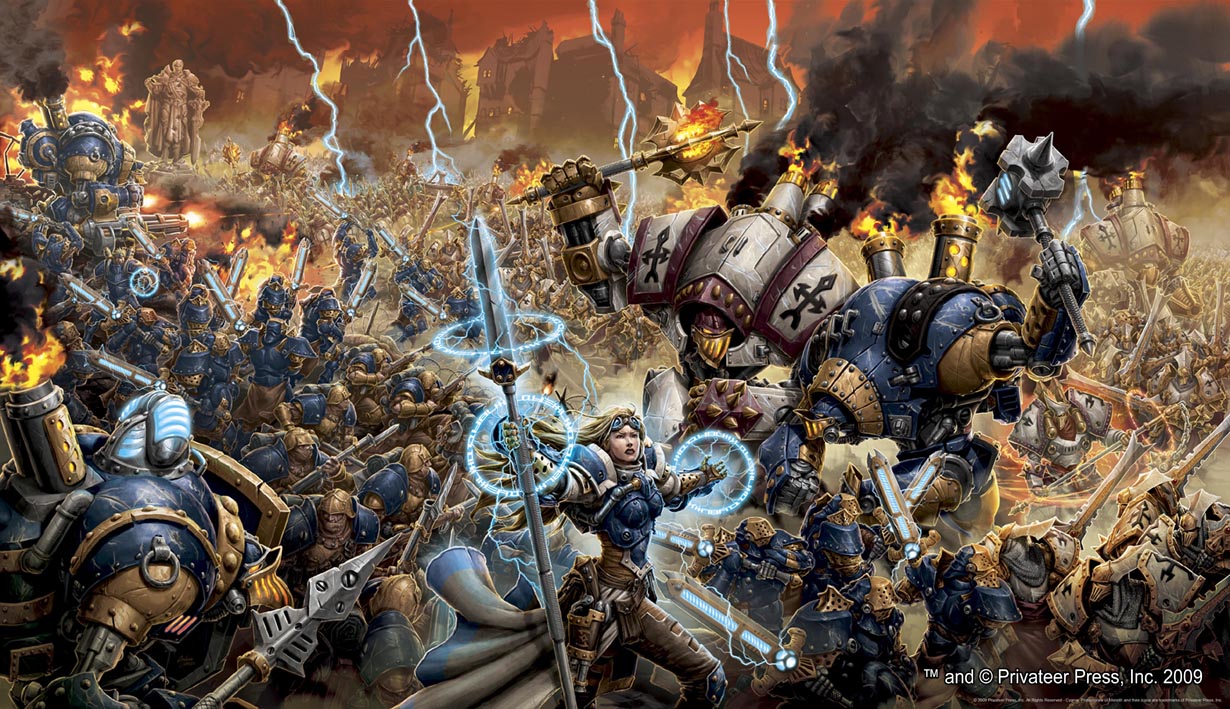
Currently popular due to the successful miniature wargames Warmachine and Hordes, the Iron Kingdoms as setting appeared for the first time in the Witchfire Trilogy (2001=: The Longest Night, Shadow of the Exile and The Legion of the Lost. They were pretty successful, as you may have guessed. Privateer Press kept expanding their catalogue with more d20 products, chief amongst them the Monsternomicon in 2002, which was really fucking good. They ended up releasing a setting campaign guide and just two years after it all started, they released Warmachine: Prime, the first version of their wargame. For a while, they stopped supporting the d20 RPG and focused on the wargames and the fiction of the Iron Kingdoms, producing an engaging setting and some rock-solid wargames, including the sister game to Warmachine, Hordes.
They kept releasing some material here and there for the RPG through their magazine, but it was just minor stuff.
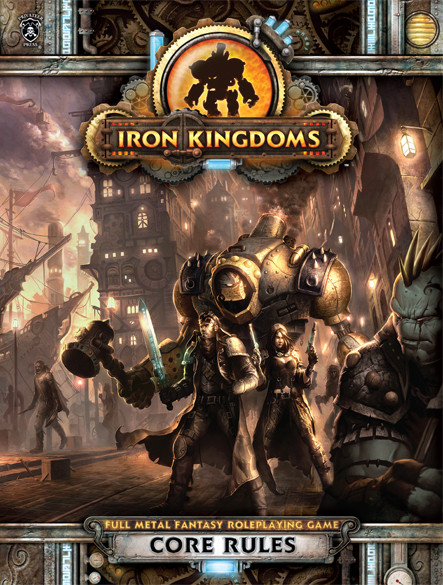
On September 19 of 2012, they published their newest RPG, whose system was based on the one used in their wargames, with some minor modifications. On the one hand, this is absolutely great since the RPG has a slow release schedule, so you can port stuff from the wargame to the RPG with only a modicum of effort required. There's also the fact that the ruleset is incredibly well-written, and avoids natural language in favor of clear and concise rules. There's no comparison between the rules arguments in Warhammer and the ones in Warmachine/Hordes. On the other hand, it's a really crunchy system where the combat is basically a miniature skirmish game, and some people might prefer games with a lighter emphasis on rules. The system uses 2d6 exclusively, and unless you convert distances to hexagons, you will need a ruler or a measuring tape. There's facing, there's flanking, there's tokens you use to track conditions on units, etc.
In my opinion, it owns and that's why I'm doing this writeup in the first place.

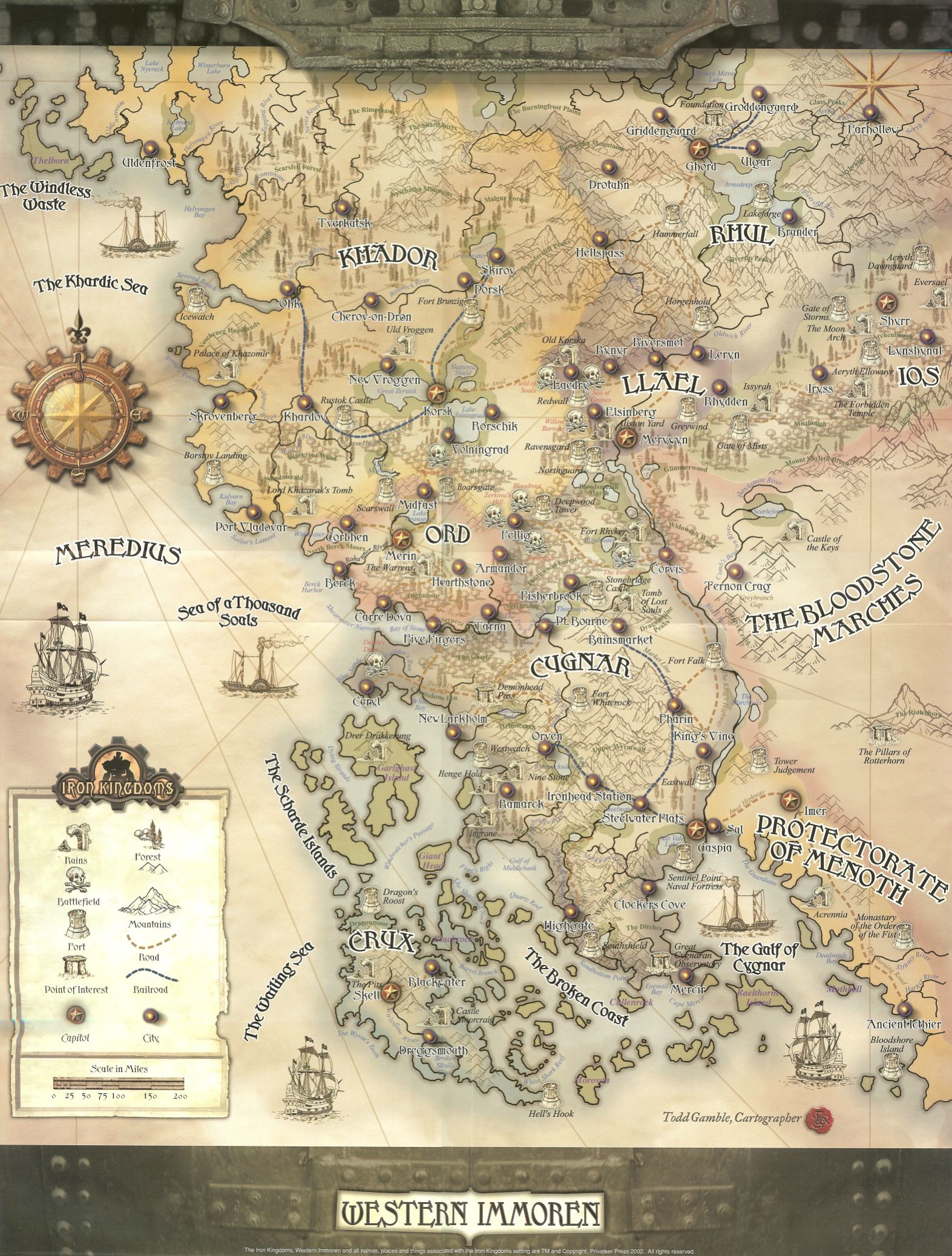
Anyways, all the events in the setting take place in the continent of Immoren, especifically the Western part. There are other continents in the world of Caen, but terrible things live there and no one has managed to go there and return. Basically no one even attempts the journey in the first place, but that's not something you can say of the residents of these other continents, as you'll see.
You have a pretty standard display of races, you have humans (the main driving force of the setting), dwarves, elves, goblins, ogres, trolls, etc. What's interesting is what the setting does with these races.
The Elvish (Iosan) and Dwarf (Rhullic) nations were already pretty advanced by the time Humans start to appear. Gods are a real and powerful presence in the setting, and when Humanity finds The Canon of True Law in the ruins of Icthier, the worship of Menoth (an Old Testament-style deity) starts.
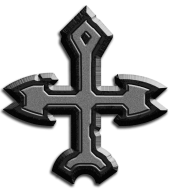
Menoth grants Humanity the access to fire, and raises the first wall. This would prove instrumental against the Molgur, wild tribes sworn to the primeval god of destruction, the Devourer Wurm.
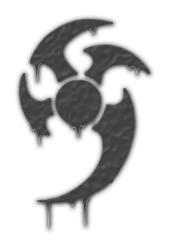
Menoth and the Wurm are basically opposites, order and chaos. Menoth provides his faithful with the technology and resources needed to fight back against the Molgur, but refuses to intervene in any other way. Menoth is kind of a dick - he asks for complete dedication to him, and is a wrathful deity, but he has a hands-off approach. The Wurm just doesn't care, since he basically owns Urcaen, which is basically a metaphyisical afterlife. There are rivers and forests and cliffs and shit. Whenever someone dies, they get to be chased around by the Wurm and his spiritual followers. Yay. Menoth raises the City of Souls, where his faithful will reside once they die, and will man the walls, keeping the chaos of the Wurm away.
Meanwhile, the Rhullic clans end a civil war and the Iosan elves try and create a bridge that connects Caen to the realm where their gods reside, the Veld. The gods can at last join their offspring in the material realm, but the bridge explodes while the Iosan gods cross it, destroying elvish civilization. Whoops. This forces to remaining Iosans, who are on the verge of extinction, to cross the newly created Bloodstone Marshes (a hellish desert made by the destruction of their god brige) while being harassed by the tribes that hated them, chief amongst them the Skorne. But hey - at least their gods are with them.
Meanwhile, Humanity manages to get its shit together and forges their first civilized kingdom, Morrdh. Meanwhile, far away, the first dragon, Toruk creates its offspring because he wants individuals to adore him. Dragons in the setting are immortal unless their soul stone, their Athanc, is destroyed. Which is incredibly difficult. They can separate shards of their athanc to create more dragons - so Toruk is basically weakening himself to create other dragons. Dragons being dicks, there's no way this will backfire. No sir.
A succession of Priest Kings rise and fall, forming the kingdom of Khard and the hold of Caspia, which will be two of the most important regions in the entirety of Immoren, in what will be known as the Warlord Era.
But then something happens, a pair of twins are born: Morrow and Thamar. The twins generate a schism in the Menoth faith, and ascend after the March to Caspia - they are now gods.
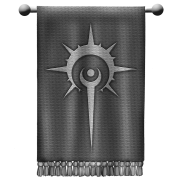
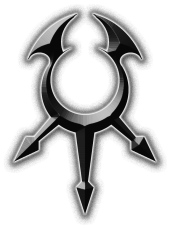
The cult of Morrow starts to expand, mainly because Morrow is not a dick like Menoth, but the latter is way stronger. Tribes in Khador fight for dominance while the Menoth priests start a purge (Menoth priests are basically the Gestapo).
The Trollkin, relatives of full-blood trolls, start to migrate north on their own, no longer part of the crushed Molgur tribes, who had been bled dry by the war against Humanity.
In other news, the elven gods left to search for answers regarding how to go back to the Veld; a printing press was developed by the humans and Toruk's offspring has started a draconic civil war where their father is hunting them down to eat their athancs. One of these is more important than the other ones!
The dragons had fled into Western Immoren, rallied and fought Toruk back into a standstill. Toruk went into the Scharde Isles to lick his wounds, overpowered the pirate kings residing there and named himself Lord Toruk of Cryx. Since dragons in this setting are basically anathema to life, Cryx gets corrupted by Toruk's presence and becomes a land full of undead and terrible things.
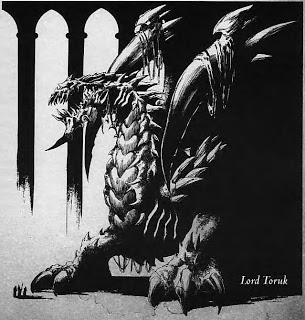
The brightest of his offspring, Everblight, decided to lay down near Morrdh, where he begins toying with the Blight dragons generate, being the only one who actually learns how to use it to craft dragonspawn. Morrdh was named "the Black Kingdom" for a reason, and they used magic against their many, many enemies. Everblight struck a deal, offering his insight while he crashed in Morrdh's proverbial couch. He got brazen, started acting recklessly and Toruk found out he was residing there. He made the Morddh lords betray his son, and took matters into his own hand. Everblight almost got devoured, but he managed to escape his father by leading him into the lair of one of his brothers.
 Everblight owns.
Everblight owns.
But Morddh got disintegrated and no one knew why.
A group of Iosan elves find their god of winter, Nyssor, inside an icy chasm, frozen. They decide to settle north, becoming the Nyss, winter elves.
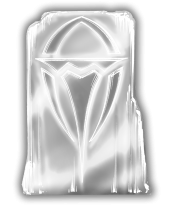
Oh, and humanity managed to make the first steam engine. Congrats.

And then something big happens. The Orgoth invade.
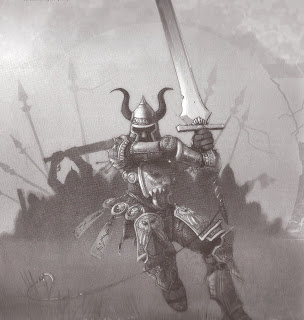
The Orgoth are from another continent, and are basically viking in steroids, who wield black magic. They begin conquering the human realms, who had spread out into thousands of independent warring states. The Orgoth society was extremely militaristic and, two centuries later, they had completely occupied human Immoren. Their attempts to invade Cryx and Ios were repelled extremely hard, and they kept a truce with the dwarves. Only humans were shit out of luck.
And then Thamar, Morrow's sister imparts The Gift on mankined. Magic. She actually negotiated it with... something or someone. The elves suffer The Rivening, making almost all the Iosan clerics go mad and lose their power. Iosans not being able to catch a break is kind of a recurring theme. Scyrah, one of the elven godesses, returns but refuses to speak of the Iosan god's fate, falling into a coma.
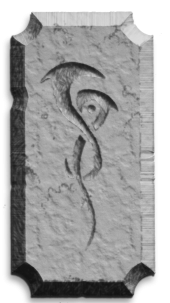
Humanity starts to develop their magic talent, penning down the theory behind magic and its implementation regarding technology. The Orgoth start crushing down rebellions, till someone invents the first firearm. The war starts to go against the Orgoth for a bit, till their tried and true tactic of "kill everything" manages to give them the upper hand again.
Then, the Immoreans start building something else. Something bigger.
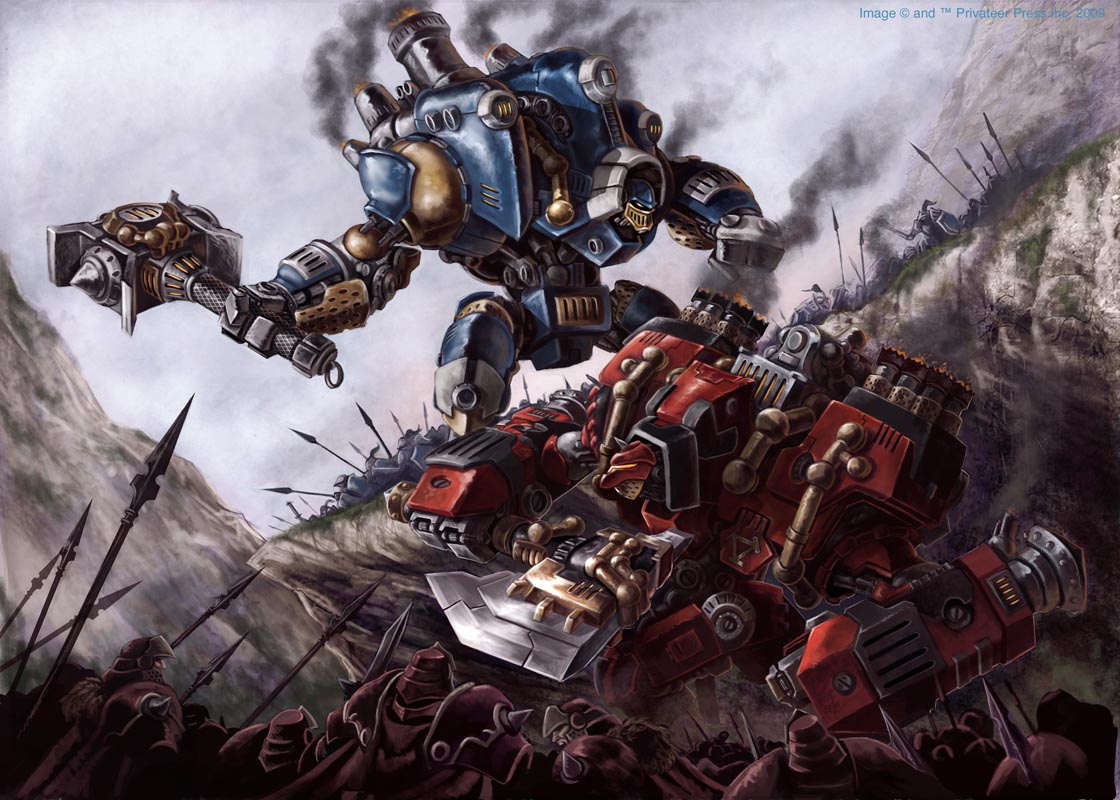
The Colossals start being built in Caspia and Khard. To gain time, the rebels decide to give information regarding the Khardian factories to the Orgoth, and manage to crank out the first Colossal while the Khardian facilities are butchered. The Orgoth are starting to get beaten more handily now, and they decide to go all-out, using all kinds of terrible shadow magic. The last Orgoth depart the continent, their hand forced due to some disease murdering the everloving shit out of their civilization across the sea. The Rebellion marks year 0 in the Western Immoren calendar, the Orgoth were finally expulsed in 201 After Rebellion.
A Council of Ten is elected during the newly-arrived Era of the Iron Kingdoms, where the Corvis Treaties are signed, establishing the new Iron Kingdoms: Cygnar, Khador, Ord and Llael (and Cryx technically counts but they are dicks).
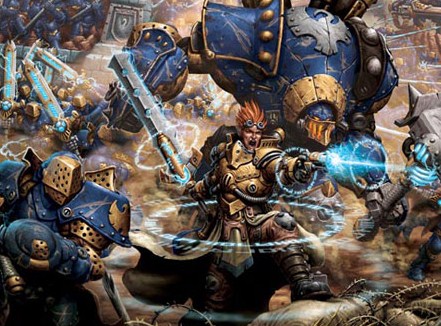
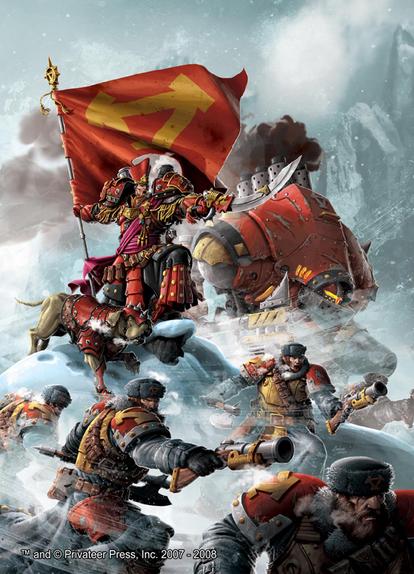
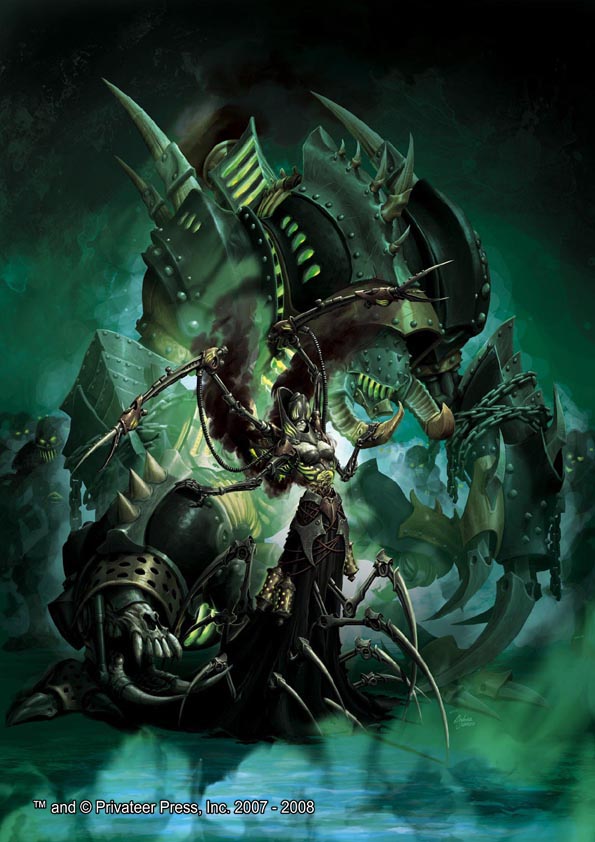
(Llael and Ord are minor, they don't get cool art)
A bunch of shit happens from here on onwards - the Khadorians are pissed as hell due to the way they were thrown to the wolves during the Rebellion, the Trollkin rise up in arms when the Corvis Treaties promises regarding their captured lands went ignored.
They start gathering alongside their full-blooded cousins, the actual trolls and manage something no one expected:
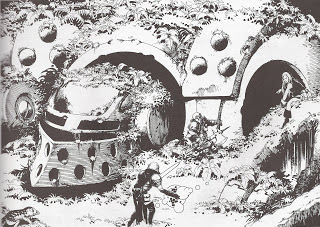
They start destroying Colossals. This forces the Iron Kingdoms to make smaller robots, called Warjacks. The Trollkin are finally beat back.
Khador (Russia/Germany) tries to invade Ord and Llael (basically Portugal and France), and are defeated after Cygnar (UK/France) joins in their support. The Cult of Cyriss (think steampunk Adeptus Mechanicum) appears. There's another schism in Cygnar, where Menoth followers (Menites) are forced to inhabit the shithole of a desert that stretches to the right of Cygnar, forming the newest Iron Kingdom: the Protectorate of Menoth (WH40K's Imperium) after the civil killed the Menite equivalent of a Pope.
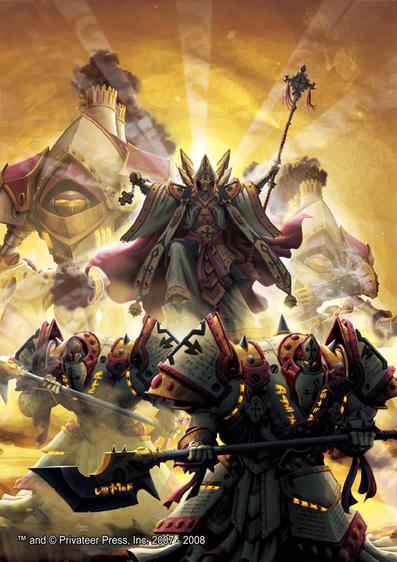
Meanwhile, Everblight had decided to leave near Ios. He corrupted Iosans in the tunnels below the elven empire till he's discovered. He burns down the city of Issyrah before being torn apart by the Iosan forces. His athanc is sent to the Top of the World to be buried, where he manages to convince an Ogryn called Thagrosh to insert it into his chest. Thagrosh and Everblight create the Legion as they descend on top of the Nyss, leaving their race on the brink of extinction.
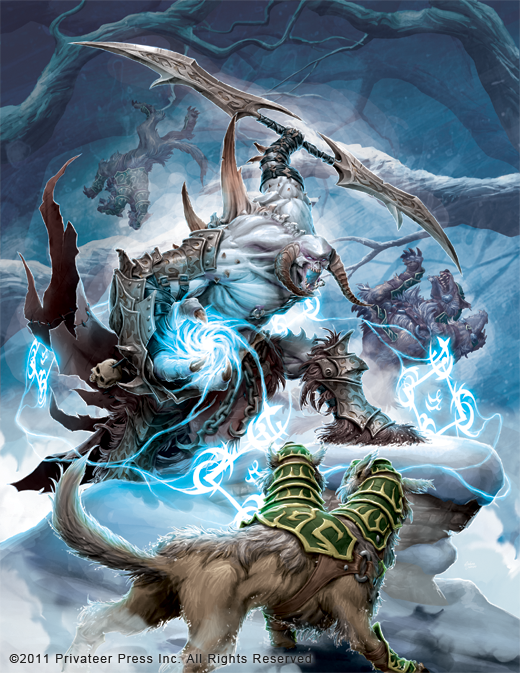
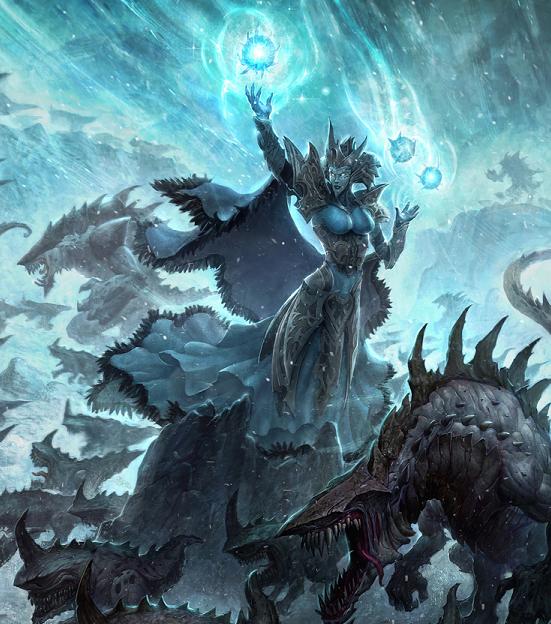
Elves and Trollkin are, indeed, the punching bag of the setting. There's another civil war in Cygnar, where the king's brother overthrows his despotic rule (Inquisition, political purges and all) through a bloody coup. The overthrown king, Vinter Raelthorne, escapes, leaving his brother Leto in power. Meanwhile the Protectorate starts converting the Idrian desert tribes to their cause, while smuggling warjack parts from Khador to create their own army. Ios starts being even more isolationist.
In the years where the RPG starts, the following stuff is happening:
- The dwarves have sat back to enjoy the riches brought by their trade relations with literally the entire continent while sending mercenaries out to make a profit from the wars flaring up between the Iron Kingdoms.
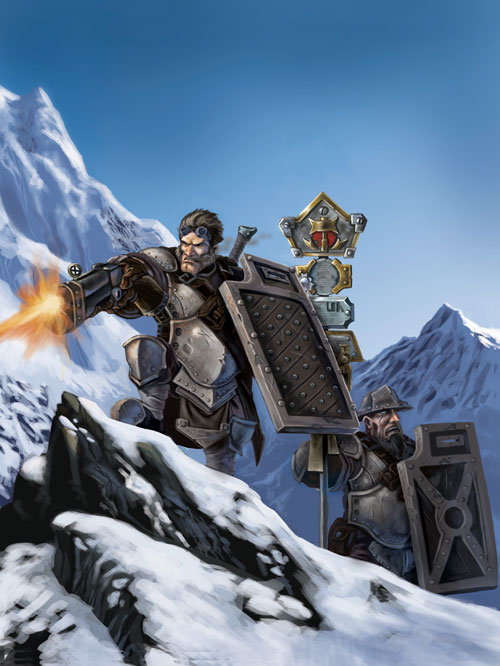
- The militaristic Skorne (remember those guys?) empire started marching across the Marshes towards Cygnar while being led by the overthrown (but rightful king) Vinter.
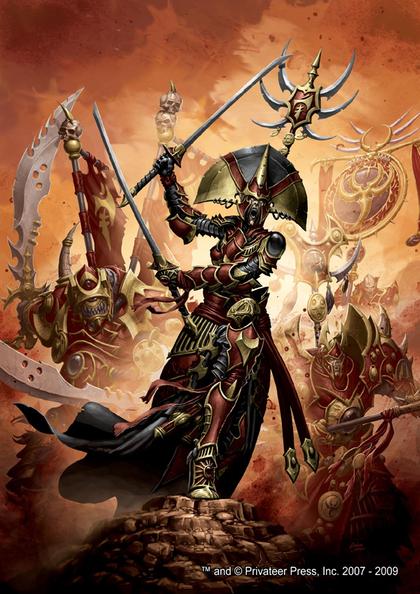
- Khador has occupied Llael (
 ) while starting a war with Cygnar, Ord sits uncomfortably in the middle.
) while starting a war with Cygnar, Ord sits uncomfortably in the middle.
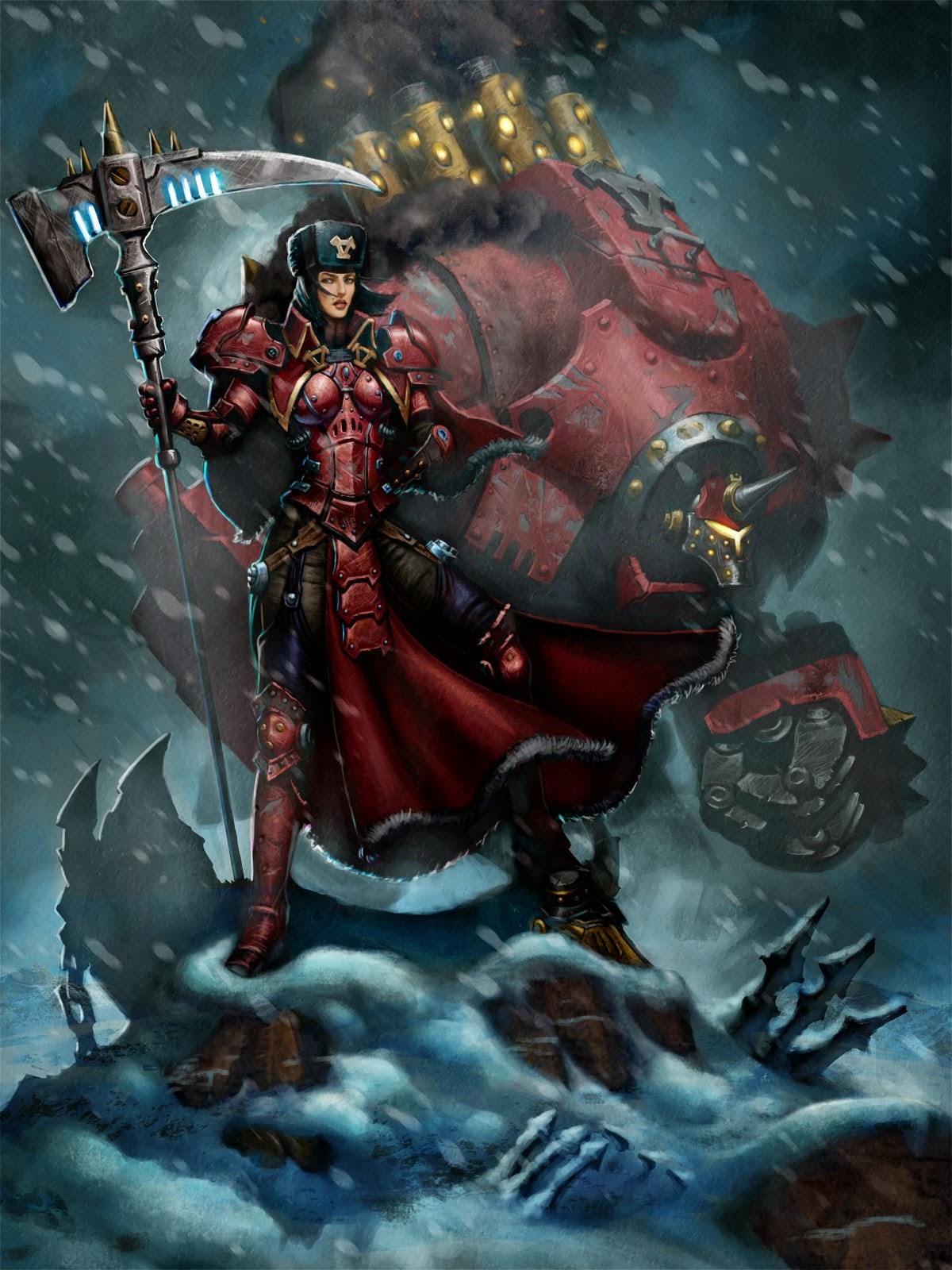
- Everblight is rolling all over the north while amassing a huge Nyss and draconic army, with the idea of killing Toruk.
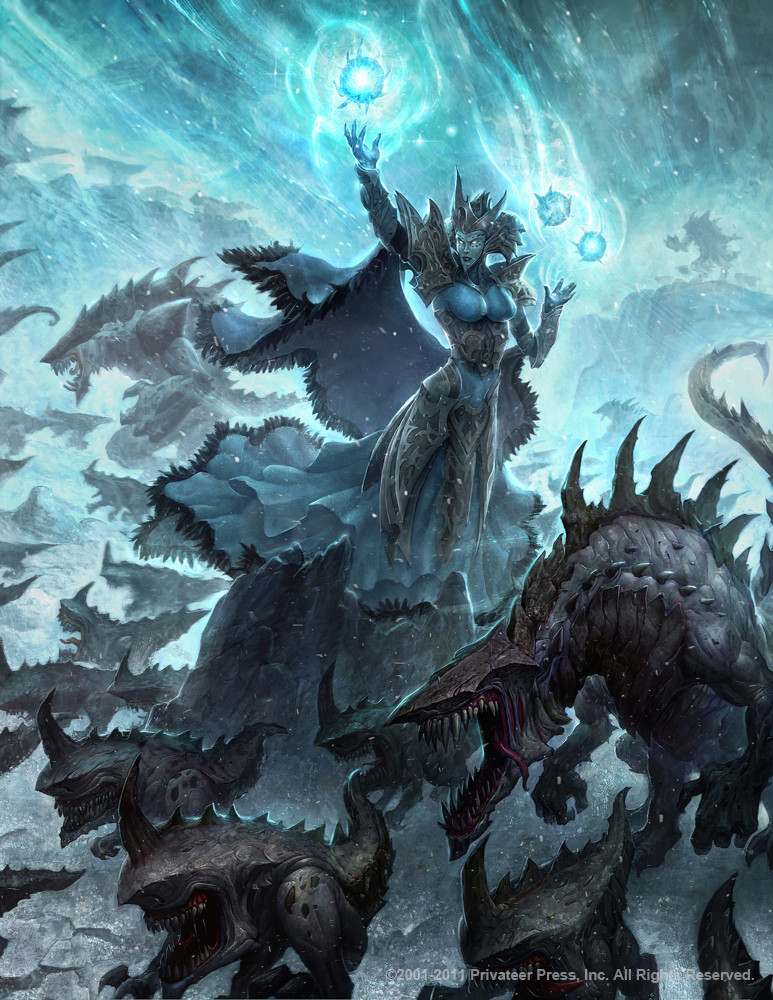
- The Druids of Orboros (the guys who keep the Devourer Wurm in check) start being more hostile towards civization in a desperate attempt to stave off the IK-equivalent of Armaggedon (brought by the Wurm turning his attention back to Caen)
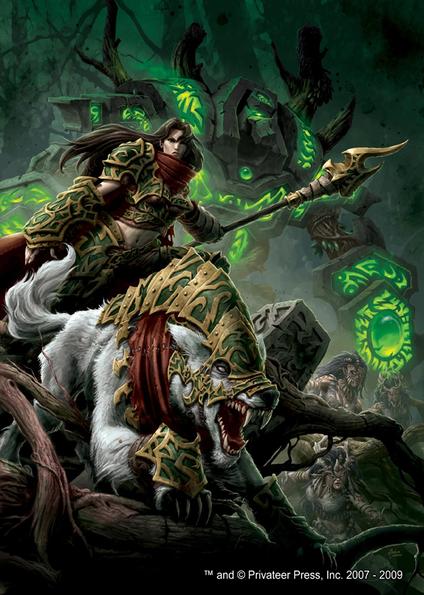
- The Trollkin start rallying their tribes to fight for their rights.
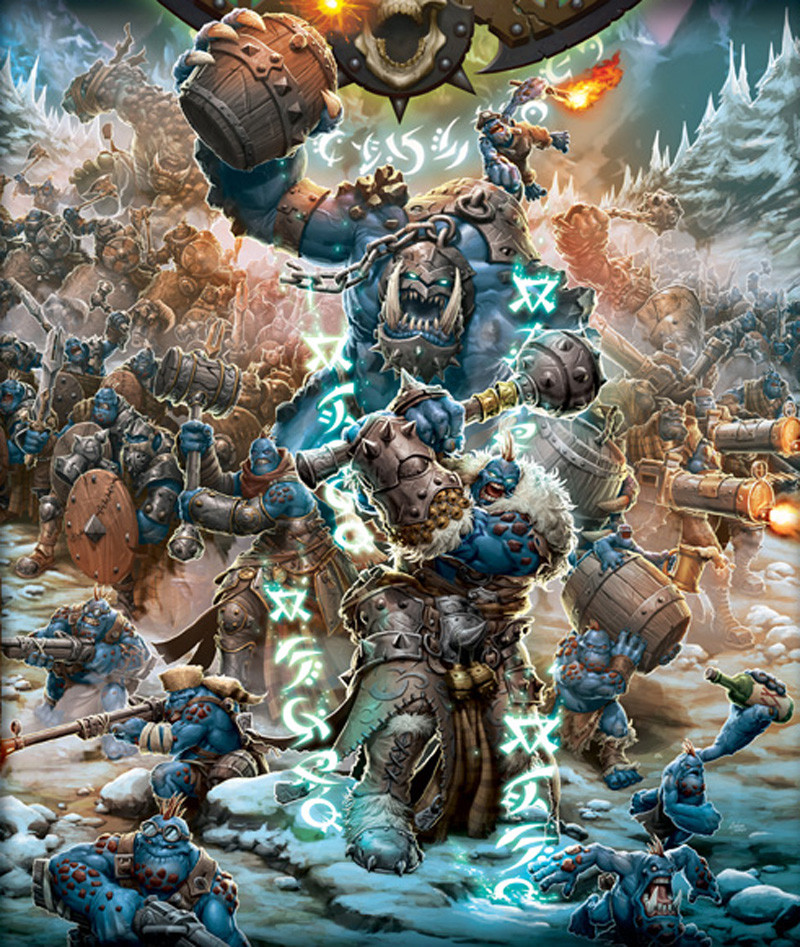
- Cryx starts to attack more ruthlessly the coast of Cygnar while creating a hidden factory city below the continent.
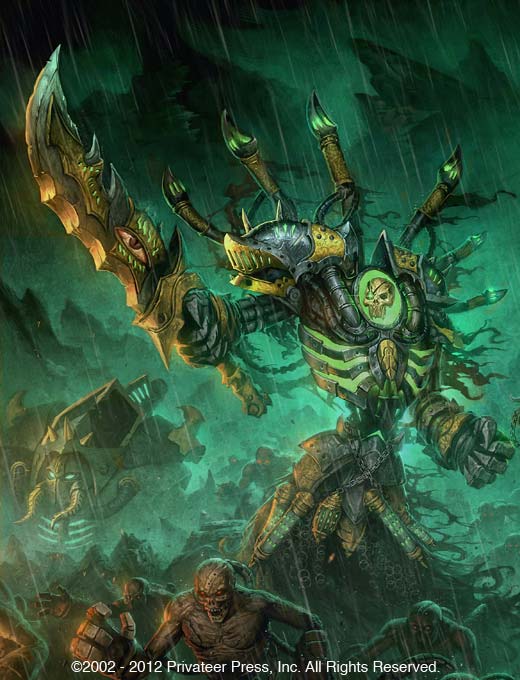
- The Retribution of Scyrah, an Iosan extremist faction, decides that Human magic is what killed their gods and start accruing favor inside their homeland, eventually marching to war to end with human sorcery. Not because they think this is how they will survive, oh no. They just want to murder as many humans as possible before the end.

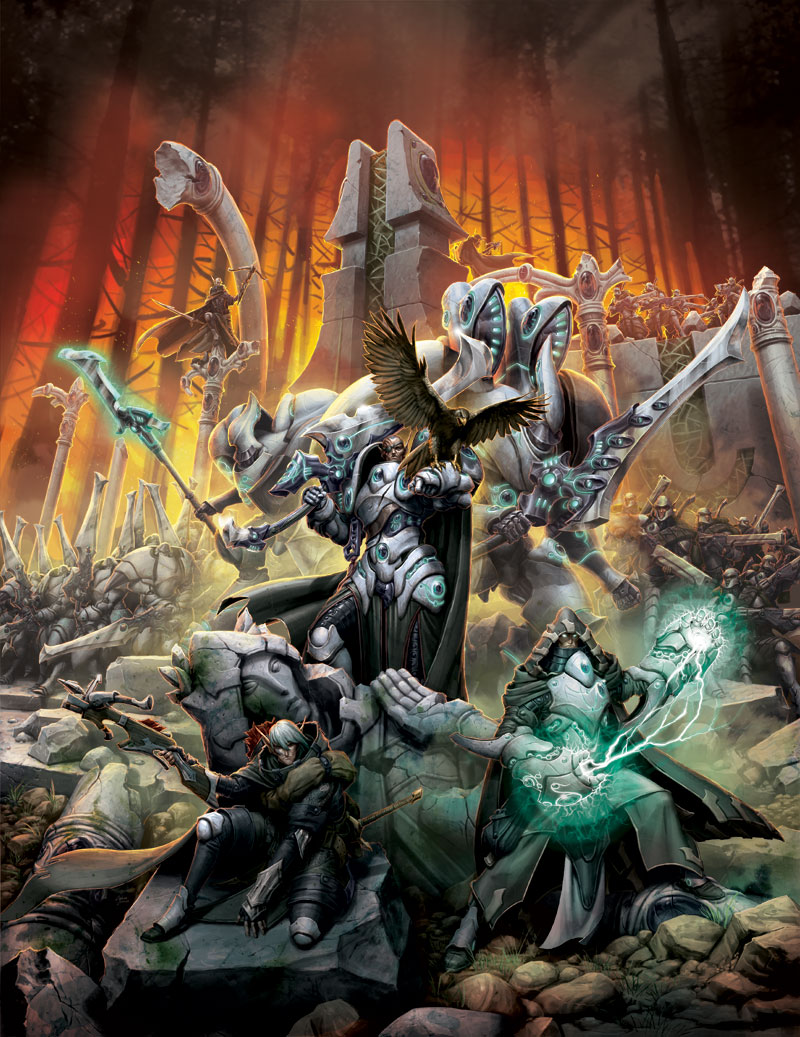
- The Protectorate of Menoth has tried and failed to invade the Cygnarian capital, getting their Combat Pope murdered once again. Now, they try to liberate (and convert) Llael.
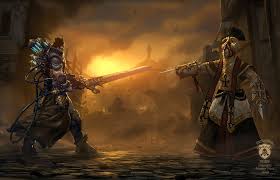
- The Cult of Cyriss goes to war.
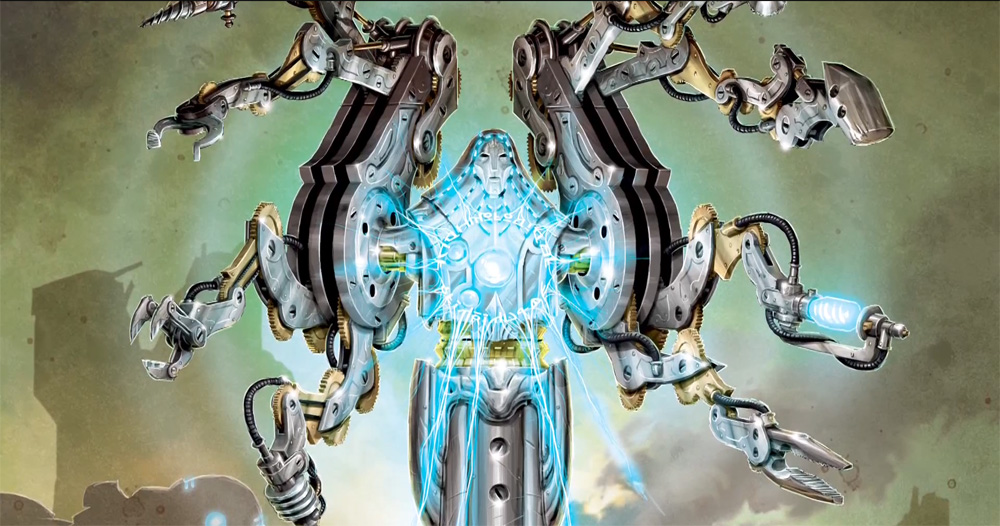
-Eldritch horrors stir in the depths and corners of the earth.
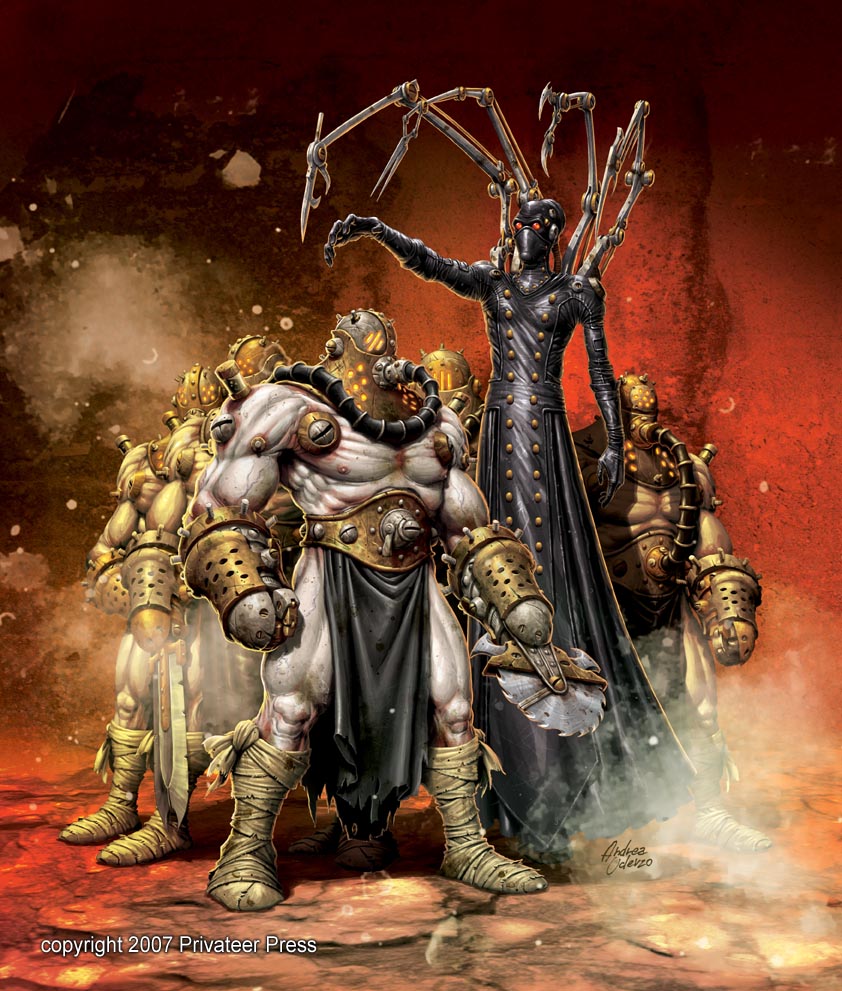
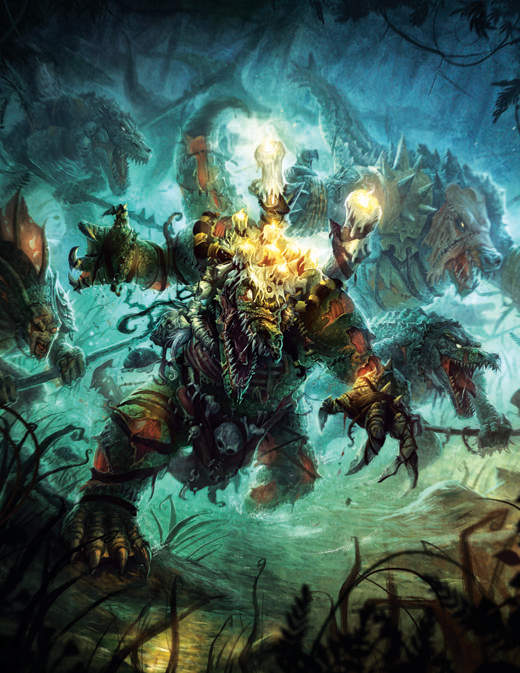
- Mercenaries are living the dream.
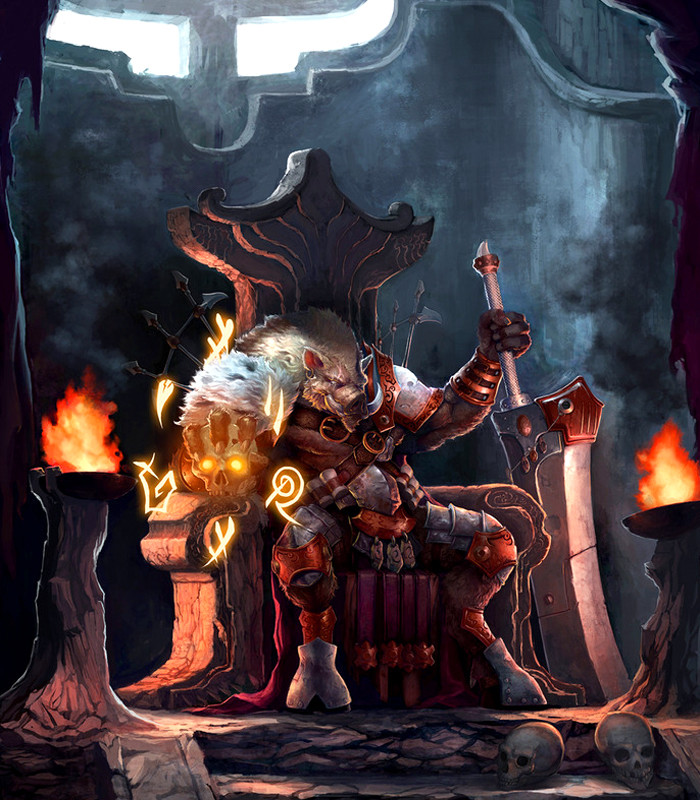
And that would be a fast version of the entire history of the setting.
 I hope you've enjoyed the trip so far, I'm planning to revisit factions in detail after going through the mechanics.
I hope you've enjoyed the trip so far, I'm planning to revisit factions in detail after going through the mechanics.
Next time, character creation and actual game mechanics
Mechanics and Character Creation
Original SA post
Alright, sorry for the delay. Stuff happened. Anyways, time for two of my favourite things - resolution mechanics and character creation! Sorry for the lore dump on the previous one, I wanted to get the setting out of the way.

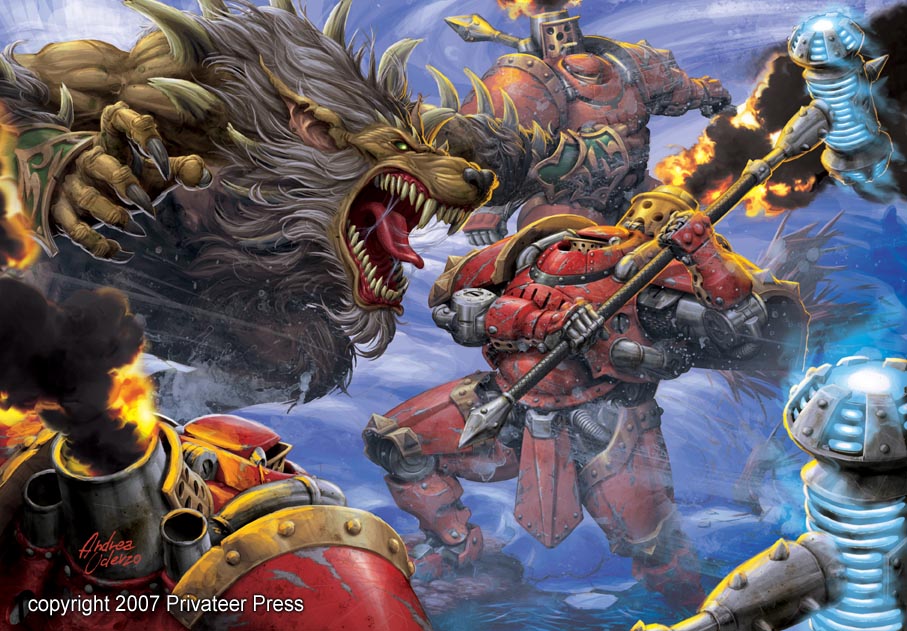
Task Resolution Mechanic
Iron Kingdoms, just like its bigger brothers Warmachine and Hordes, is a game that only uses d6. You normally roll 2d6, plus or minus some modifier (normally +/- 2s) and try to beat a certain number, normally a Difficulty, Defense or Armor value. In fact, the RPG shares almost 99% of its combat rules with the wargames.
 The main addition is that you add attribute bonii to your rolls.
The main addition is that you add attribute bonii to your rolls.
Characters have multiple attributes, 5-6 being the average for the ones you'd use on a roll, and 12 for the ones you'd be rolling against. Since it is a 2d6 system, numbers aren't too crazy and I think it is part of the appeal. There are ways to add dice, but the most you'll see is 6d6. The other part of the appeal is the way rules are written - no shitty naturalistic language, like I said in last update. Rules are clear and concise.
Combat
Movement is determined by inches instead of squares or hexes. An average human will move 6 inches per turn, unless he runs or charges (12' and 9', respectively). Miniatures are basically mandatory, especially since line of sight and cover are determined by base size.
The fighting itself is pretty simple. You have three different attack ratings: melee, ranged and magic. You add them to your roll, and compare it to your opponent's Defense. If your roll is equal or above the DEF value, you hit. For damage, you roll again, this time adding your weapon's Power (and Strength, if it is a melee or thrown weapon). Every point that goes above the target's Armor value (ARM) is a point of damage. Which reminds me of something:
 THIS SYSTEM IS LETHAL.
THIS SYSTEM IS LETHAL.
 Have an example:
Have an example:
A thug (Defense 12) is shot at by a ranged-focused PC using a rifle (Ranged Attack Rating 6). He rolls 2d6 + 6, gets a 13 and hits. The thug's armor value is 12. The rifle's Power is 11. The PC rolls 2d6 + 11 and gets an 18. The thug receives 6 wounds and drops dead, because he only had 5.
Another thug charges the PC (Melee Attack Rating 5) and rolls against his victim's defense (DEF 13), rolls a 9 and hits. Since he's charging, he adds a d6 to his damage roll. He's using a sword, so he's doing 3d6 + P+S 8 (Power 3 + Strength 5) against the PC. The player character is using light armor, so he's got an ARM 11. The thug's roll is pretty average, 18 in total. So that's 7 damage and the PC is on almost dead.

Granted, there are ways through which the player characters (and boss enemies) can reduce the lethality of combat. But this isn't D&D, you won't be comfortably sitting at 200 HP. You'll have 20 points of damage and be grateful for it.
In general, ranged and magic are not as good as melee. Melee characters will roll more damage dice, and ranged characters don't have that much of a range advantage. A regular ass soldier with a spear can charge 9 inches, while adding 2 inches from his spear's Reach property. That's a threat range of 11 inches, while the most ranged weapons and spells have Ranges (RNG) that go from 10' to 12'. Only the absolute best handheld guns have RNG 14, at most. The spear-armed fellow will roll 3d6 + 9 on a charge, while the ranged character will normally roll 2d6 + 11 if he's using a rifle.
Luckily, there are ways for ranged and magic characters to deal with this, and we will see them in a bit.
There's just one Defense and one Armor value for every character, but different types of protection can grant extra DEF or ARM against certain types of attacks. Spells like Deacceleration adds +2 to a character's DEF against ranged attacks, while the Unyielding ability adds +2 ARM whenever the character is engaged in melee.
Magic is pretty combat-centered, and melee and magic characters have just as equal amounts of plot agency - there's no Resurrection or Wish spells here, and magical Healing has severe side effects due to the way magic works in the setting. Magic powers rely more on their effects than their range or damage, since even the very powerful spells will only be hitting for POW 14 or 15.
There's only one kind of magic, no distinction between divine, arcane, etc. There are some slight differences in WHERE that magic comes from for different factions, but the game treats them all in the same way. What matters is your Arcane Tradition - whether you are a Will Weaver or a Focuser. Both of them are born with The Gift of magic, but it's the way they've learned to use that makes them different.
A Will Weaver, as the name implies, uses his will to use magic. Whenever you cast a spell, you pay its cost in Fatigue Points that stay with you after your turn. If your Fatigue points go over your threshold, you run several risks, like not being able to keep your upkeep spells in play or not being able to cast at all. You can remove some of them from turn to turn, but a character that's in a dangerous or desperate situation may need to push his powers beyond his Fatigue threshold.
A Focuser, instead, doesn't deal with Fatigue, since they have a completely innate understanding of magic that doesn't put a toll on their bodies. Every turn, they generate Focus points. They can use Focus points to cast spells amongst other things, and at the beginning of every turn their focus reserve is replenished. Focusers cannot push themselves, their resources are safe but limited.
Will Weavers have a risk/reward thing going on, while Focusers are centered on resource management. Neither of them have to adhere to the idea of lightly armored wizards - war mages in the Iron Kingdoms can be clad in fully enclosed plate and stil cast just as fine.
In comparison to the combat (which, as you can tell, is the focus of this system), skills have pretty standard rules. There are General skills (things like Swimming, Gamble, Riding, etc) that all characters have access to, while specialized skills (like Seduce or Charm) are limited to certain careers. For skills, you roll your skill level + the corresponding attribute (which is not fixed, you can Charm or Seduce - for example - with Strength or Intelligence) against a certain Difficulty. The rulebook specifies some degrees of success and failure for certain skills, but nothing universal. It's my major issue with the system, but whatever - at least its better than what you get in D&D.
Finally, characters get feat points they can use to activate feats, pass rolls, halve damage received, etc. You get them pretty easily, so the game expects players will be constantly using them while the GM will be awarding them just as fast.
I should add, before getting into character creation, that this is a game that LOVES its setting. The first 100 pages or so of the book are dedicated to the setting and lore.
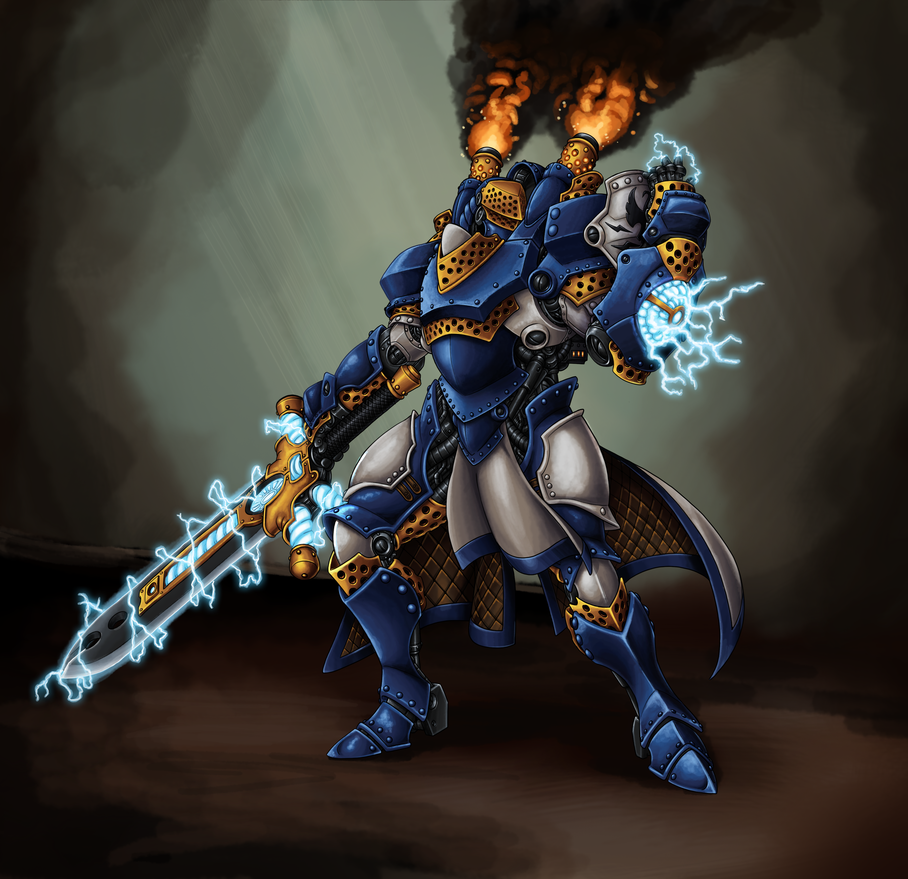
In Iron Kingdoms, you've got a decent variety when it comes to creating your character. There are three main choices to be made, and those are Race , Archetype and Careers . Yup, plural. The IKRPG makes character creation seriously fun and flexible.
Characters have a 9-stat spread, separated in three Branches. You've got:
Physique (PHY, defines toughness, Armor and Willpower)
- Speed (SPD, determines your movement speed, Initiative and Defense)
- Strength (STR, determines your melee damage and physical-related thresholds)
Agility (AGL, mostly used for skills that require coordination and reflexes. It's also used for Defense)
- Prowess (PRW, used to determine your Melee Attack Rating and Initiative)
- Poise (POI, used to determine your Ranged Attack Rating)
Intellect (INT, used for skills and Willpower)
- Arcane (ARC, used to determine a character's skill at offensive magic)
- Perception (PER, used for Initiative and Defense)
PHY, AGL and INT are important for all characters, since their numbers define their damage circles on their life spiral. Losing all your points in the PHY, AGL or INT branches of your life spiral carries different penalties depending on the damaged branch of the spiral.
The derived stats are Melee Attack Rating, (MAT), Ranged Attack Rating (RAT), Defense (DEF), Initiative, Command Range, Armor (ARM) and Willpower (WIL).
A character also has Abilities, Connections and Skills, to be detailed later.
Races
First of all, races have starting stats, with their own racial limits. They can range from 2 to 10, but the average range will be 4 to 7. Every character gets 3 points to spend to improve their stats at the end of race selection, that can't go over the specified racial limit (three different types - Hero, Vet and Epic, according to the amount of EXP the character starts with/has).
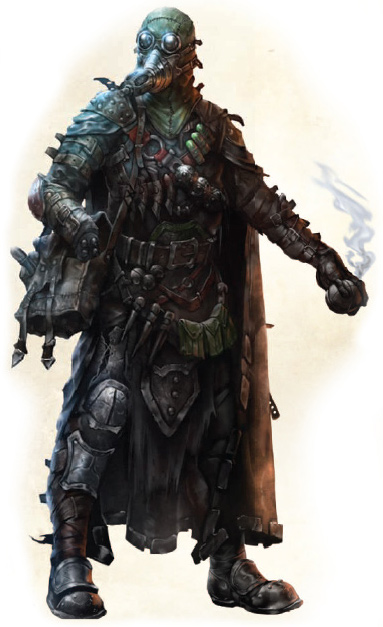
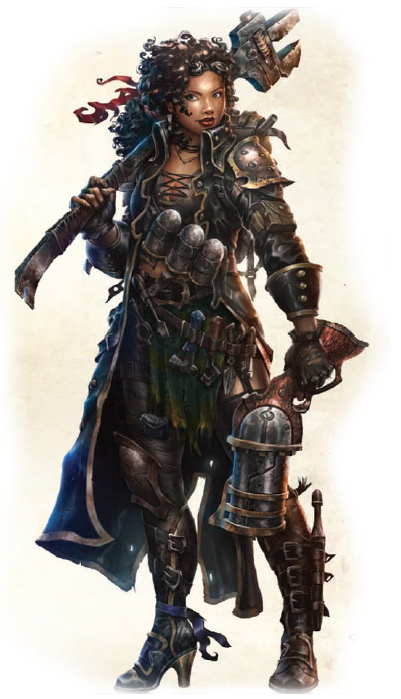
Humans are average but diverse. They don't have any mediocre values, having most of their stuff at 3 or 4, while their speed (6) and physique (5) are downright lovely. Their maximum values all rest at 7, except for Arcane, Strength and Physique, which sit at 8. They get a fourth stat point to spend to increase their stats, but it can only be spent in PHY, AGL or INT. At the very least, a human character will have a respectable 12 damage circles on their life spiral.
They start with two languages, their national one and another one they picked up during their travels. So a Cygnarian or Menite from the Protectorate will speak Cygnarian/Sulese (same fucking thing by different names), a Khadorian will speak Khadorian, an Ordic will speak Ordic and a Llaelese will speak Llaelese.

They can be Mighty, Intellectual, Skilled or Gifted. (More on archetypes later)
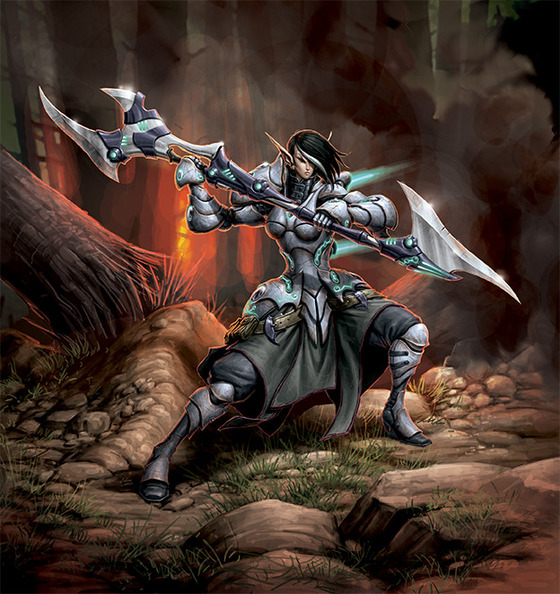
Iosan elves are the High Elves of the setting. They tend to be aloof and xenophobic, while also being kind of tragic due to the way their civilization has been brought down from their former glory. They are slightly more intelligent than humans, while sharing their other stats. Except for Arcane, their maximum stats are 7. Elves in this setting are highly technologically advanced xenophobic assholes, while also having beards and cigars. I kind of like the IK's take on them just as much as I like their dragon concept.
Iosan characters can start with an additional ability selected from their careers, and this is kind of huge, due to the way advancement works.
They know Shyr and some other language.
They can be Mighty, Intellectual, Skilled or Gifted.
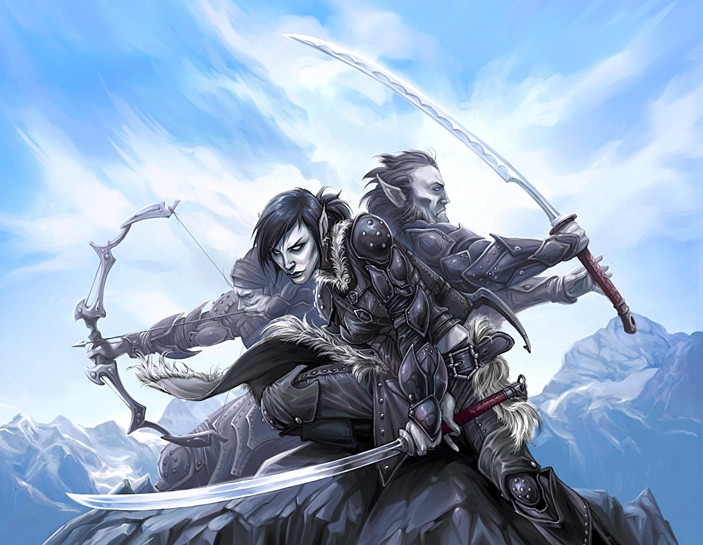
Nyss are winter elves. They are just like Humans, but more agile. They can't be as perceptive or smart, but they can be just as tough or strong. They are also huge weaaboos, their favourite weapons being the nyss claymore (a.k.a katana) and nyss bow. In fact, these two weapons are 10gc cheaper for them! They are also pretty good. Nyss also get a +1 to Initiative and Perception rolls, +3 ARM against Cold effects and -3 ARM against fire effects.
They speak Aeric and some other language they've picked up.
Nyss can be Gifted, Mighty or Skilled. Gifted Nyss can't be Arcane Mechaniks, Gun Mages, Arcanists or Warcasters.
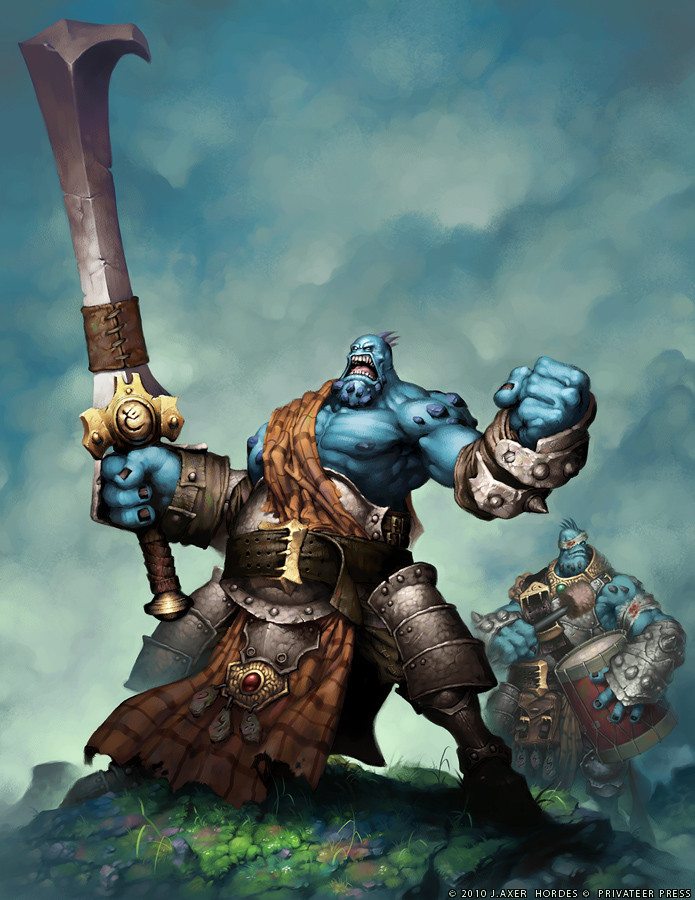
Trollkin are a really weird mix of real life cultures, mostly Scottish with a slight hint of American and Norse elements depending on their origin. They are slower and poorer shots than humans, but tougher, stronger and more skilled at melee. Their PHY can reach an impressive 10, while their STR can go all the way up to 9. Their POI, SPD, INT and PER can only go to 6 though.
They know Molgur-Trul and some other language, while having the Tough and Feat: Revitalize abilities. Basically, whenever they get incapacitated they can roll a d6. On a roll of 5-6, they just stand back up. And there's no limit to how many times you can roll for it. Revitalize is also similar to a D&D 4e's Healing Surge, so Trollkin are incredibly hardy fuckers to kill. They are the closest thing the setting has to a "good guy" faction, even if one of their leaders likes to feed medical train wagons to his trolls. Whoops.
They can be Mighty, Skilled or Gifted. They can't be Arcanists, Arcane Mechaniks or Warcasters.
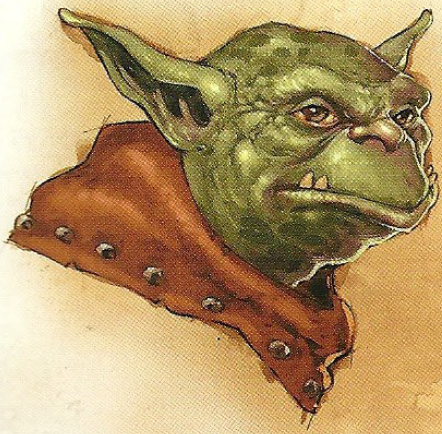
Gobbers are gipsy goblins, in a nutshell. They tend to be pariahs living at the corners of society or in caravans, but they are extremely good at mechanik stuff. They get the Deft archetype bonus from the get go, which means they get boosted rolls whenever they do AGL-related stuff. They can't use rifles or great weapons such as lances or halberds, but get a +1 bonus to DEF. Poor Gobbers are kind screwed in the stat department - while their starting stats are like those of a Human (except more agile), barely more than half their stuff can reach 7, with STR and INT being stuck at 6, while PER only goes to 5.
They know Gobberish and some other language.
They can be Intellectual, Mighty or Skilled.
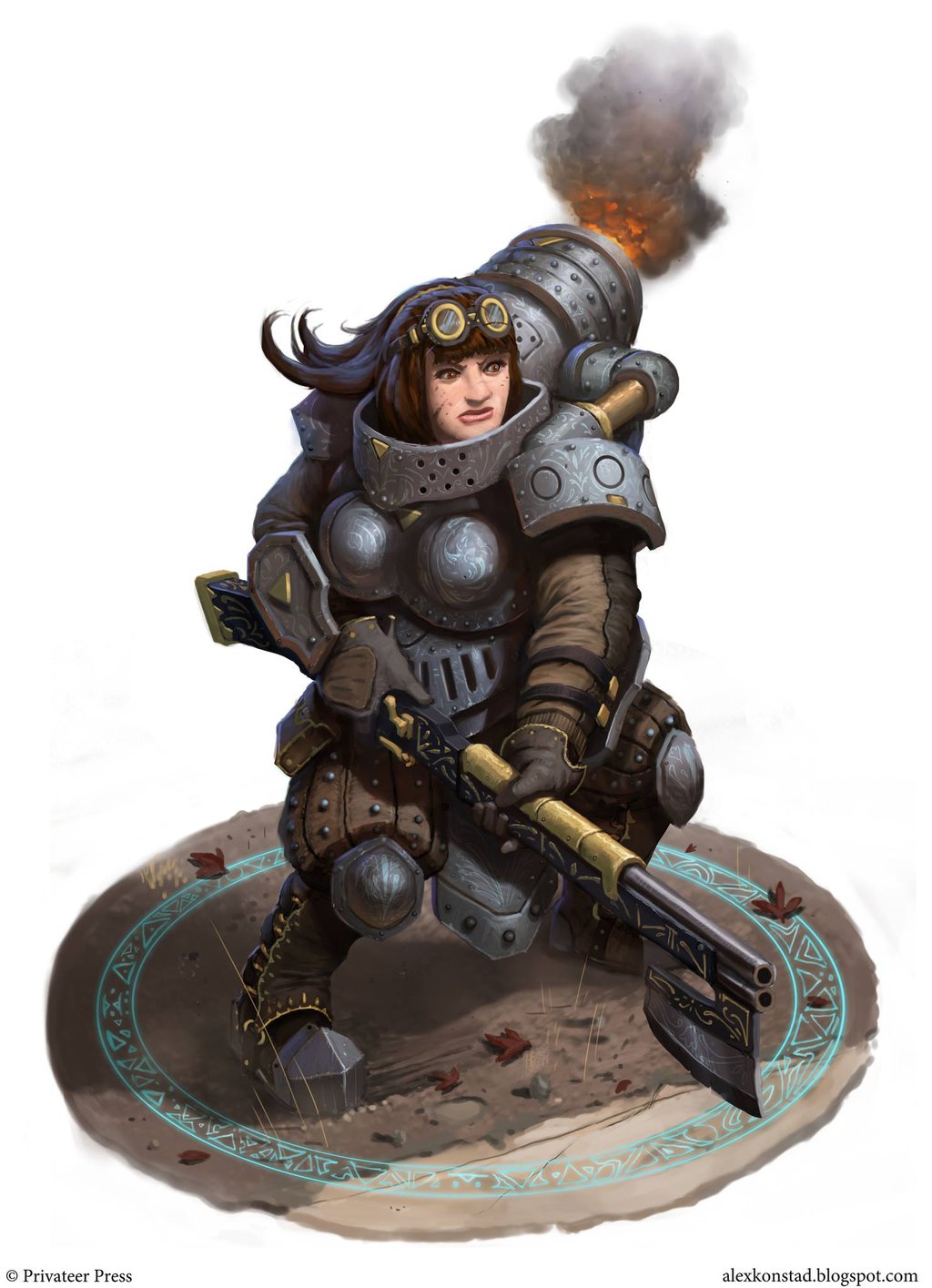
Dwarves are sloooow. SPD 4 is incredibly shitty, and can only go up to 6. Yeah, PHY and STR can go to 8 as compensation, but it sucks anyways. They are as smart as any Iosan, and aren't affected by movement penalties from the armor they wear. They get Connections (clan), more on that later.
They can be Gifted, Mighty, Skilled or Intellectual.
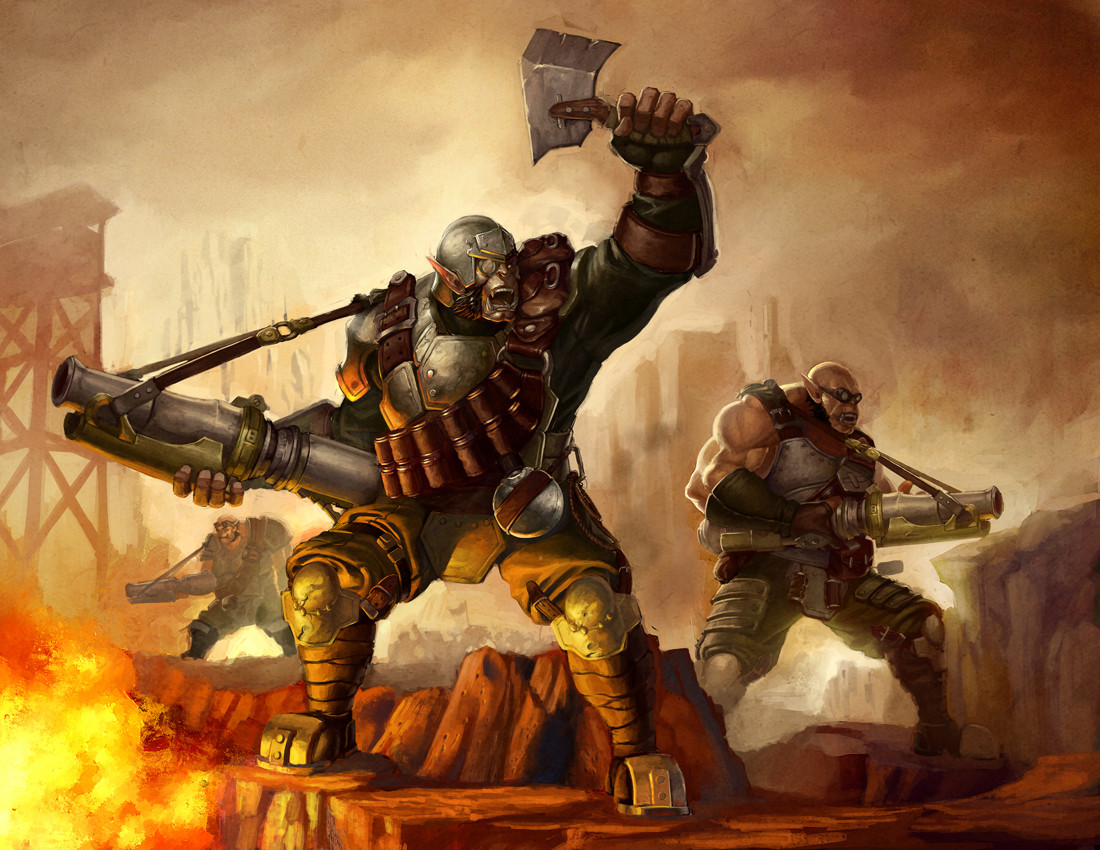
Ogrun are civilized ogres that love cash, so they end up as mercenaries often. Just like gobbers, they tend to live in pretty much all types of human settlements, but the largest groups live amongst the dwarves of Rhul. They aren't good at being perceptive, and only Prowess goes to 7, but they can reach 10 in STR and 9 in PHY. Everything else is stuck at 6. Their starting speed is Trollkin-bad, and not Dwarf-bad, but their Prowess is better than a Human.
Here's where they get screwed. Their only ability is Huge Stature - they can one-hand two-handed weapons, but suffering a -2 penalty to attack rolls. Just like Gobbers, their abilites don't make up for their stat limitations.
They get three languages: Molgur-Og, Rhulic and another one.
They can only be Mighty or Skilled.
Archetypes
There are four types of Archetypes. Just like role in d&d 4e, they define the way the character deals with problems. You get a passive ability and you get to pick a benefit.
Gifted characters can use Magic. You cannot take magic careers if you aren't gifted (something people are more than happy to houserule away). They are the only ones that have an ARC stat, plus they start with a Tradition: Focuser is they are a Warcaster, Will Weavers if they are anything else. Focusers start with 2 ARC and Will Weavers start with 3. That's their passive ability, by the way. Starting with an ARC stat.
Their benefits range from incredibly niche (Rune Reader, which allows you to recognize a spell as it is being casted, since in-game the caster would be covered in runes, or Circle of Warding) to "downright amazing" (Combat Caster; roll 3d6 whenever you cast and drop the lowest die of each roll)
Intellectual characters range from leaders to investigators. They give a non-cumulative +1 to attack and damage rolls of everyone in their command range (including themselves).
Their benefits are mostly Feats that work as orders or plans (so, kinda heavy on the RP) while others are just downright great, like being able to spend a Feat point to make an attack miss, or getting boosted INT or PER rolls.
Mighty characters like to hit things hard and survive getting hit hard. So they get an additional d6 on damage rolls whenever they roll melee damage. Note I said additional, not boosted. Since you can only boost once but there's no cap on additional dice, a Mighty character on the charge rolls 4d6 damage.

The benefits are pretty nice, if feat points-heavy: like being able to spend a feat point to make another attack, or gain +3 ARM, or heal an amount equal to PHY as many times as Feat points you have, or getting +2 STR and +2 ARM when a friendly character is damaged in your command range.
Skilled characters are, well, skilled. They get to make a second attack every turn. It sounds "eh", but it's a great benefit when you take into account how lethal the system is.
Their benefits are interesting, from +3 DEF for a feat point, or no penalty for dual wielding, to Disarm and Defensive Strike (allows you to attack as soon as an enemy gets into your range during their turn).
Careers
You pick two careers, and get the benefits from both. Some are race, creation or archetype-limited.
The game recognizes that, while the amount of options is pretty big, you may not find something that quite fits your concept, so they give you some ideas as to how you could modify your starting career's characteristics. It's a nice touch.
Now, a small summary of every career.
Alchemist : Only career that can use alchemy. You can cause a lot of havoc with the different effects your grenades can apply, from smoke or fire to dust.
Arcane Mechanik : The mechanikal crafting career. You start fucking loaded, with up to 750g spent on a mechanikal piece of armor or weapon. You're also an offensive mage. Gifted only.
Arcanist : The vanilla sorcerer. You start with Rune Reader, and it's easier for you to upkeep spells. Gifted only.
Aristocrat : You are a leader that knows his way both around a weapon and a noble court. Also, one of your starting abilities is called Privilege. You get money each month. Human and starting only.
Bounty Hunter : You are great at knocking people down to capture them, while being good at both fighting and street-related social activities.
Cutthroat : A nasty combat assassin, pretty hard to kill at range if you're smart with cover use, and really efficient whenever you team up on a target.
Duelist : You say fuck you to opportunity attacks (called free strikes) and anyone trying to shoot you or attack you thanks to Parry and Riposte.
Explorer : Jack of all trades, you get cash each month as long as you're discovering new stuff. You have a nice assortment of combat, exploration and social skills while also having plenty of cash to start with.
Fell Caller : You are a trollkin that comes from the line of Bragg. You can shout so loud that your voice becomes a shotgun, or splits the earth, or forces people to move really fast. Trollkin-only.
Field Mechanik : You are a grease monkey. But you're the only career in the game that starts with a 200gc light laborjack, and you will eventually find a way to equip with weapons.
Gun Mage : You are a mage that casts spells through his bullets, whether they come from a rifle or a pistol. Really fun to play. Gifted only.
Highwayman : You start with a horse and a mask! You also know how to shoot from the saddle.
Investigator : You investigate stuff like, really good. You get the Hyper Perception benefit, so you get boosted PER rolls if it is your initial career. Pretty much relegated to social campaigns, though you can use a couple weapons.
Iron Fang : You are an elite soldier that belongs to a pikemen order that's extremely proud and good at killing shit. So good, in fact, that their pike heads have been replaced by shaped blast charges. You must be Khadoran to take it, it must be one of your starting careers, and your second career is limited to other warfare-related careers.
Knight : You're a noble leader of men, more dedicated to smashing heads in or protecting allies than the Aristrocrat. Only available to Iosans or Humans.
Mage Hunter : You hate mages THIS much. You're connected to the Iosan's own state-approved paramilitary group, while laughing at any kind of magical protection. Iosan only.
Man-At-Arms : A defensive-minded military career, they work really well in pairs.
Military Officer : Pretty self-explanatory.
Pirate : YARR.
Pistoleer : Again, pretty self-explanatory.
Priest : Okay, this is where it gets fun. Priests can be of Morrow or Menoth, at least if you restrict yourself to the Core rulebook. Each of those gets their own spell list, Menoth priests being more in love with fire than their Morrowian fellows. Priests are basically magical leaders. Gifted and Human only.
Ranger : A career that's mostly centered around giving the finger to difficult terrain and any kind of natural exploration-related difficulties.
Rifleman : Again, no explanation needed.
Soldier : Soldiers are more survival-focused than Men-At-Arms, while having access to a more varied weapon repertoire.
Sorcerer : An elemental sorcerer. You must pick from Fire, Ice, Stone or Storm. Gifted and Starting only.
Spy : Not really a combat-centered career, and all over the place with their abilities.
Stormblade : The fellow in blue from all the way up there in the post. It's a career restricted to starting Cygnarians, while limiting your secondary career, but you get extremely expensive toys to play around with, like completely insulated plate armor and a sword that shoots lightning.
Thief : Just as the name says, up there with the Spy and the Investigator in "niche careers".
Trencher : The Cygnarian front line troops, straight out of WW1. Pretty heavily armed, with their own weapons, armor and kit and an impressive repertoire of skills, abilities and weapons, but suffer from the same restrictions that plague the Stormblade. It's also available to Ogrun and Trollkin.
Warcaster : The Warcaster is, along with the Gun Mage, one of the most iconic IK careers. You are extremely versatile: you are a focuser with a varied list of combat and support spells, can command warjacks like no one else (eventually playing your own micro version of Warmachine at a high enough level) and are pretty sturdy and hard-hitting to be a valuable combat character on their own. You also start the game with either a weapon or an armor with a Bond runeplate installed, which allows you to use your Focus to boost your attack or damage rolls (in the case of a weapon) or overload your armor's protective field (in the case of armor), but they must be fed either batteries or coal respectively. Your abilities are seriously lacking, with only six available, and access to only four types of weapons, General and Command skills. You must be Gifted and it must be one of your Starting Careers. No matter what your other career is, if you're a Warcaster you will always be a focuser. Warcasters play nice with every other career, but they start really weak.
And remember, you get to pick TWO!
There's other stuff in the other books, like Trollking bull riders, Cyriss techno priests, stormsmiths, or even Men-of-War (Khadorian soldiers in ultra-heavy boiler-powered armor) but this should be enough to give you an idea of how varied character creation can be.
And that's most of character creation. Before going on, I want the thread to pick three different combinations of race, archetype and career. I will craft them into usable characters, to show just how it all comes together. First come, first served.
Character Creation Example
Original SA postRyuujin posted:
How about a Trollkin Stone Sorcerer/Pugilist oh wait that wasn't on the list, then how about a Trollkin Stone Sorcerer/Fell Caller.
I was about to add the others careers, but something came up as I was writing it - I wanted to get this update out and I didn't even have time to get art for the classes I DID add, so heh, might do the supplements separately or something. Urban Adventures has some really cool unarmed content.
Also, I'm making a small career switch here - the Stormblade/Highwayman is going to be a Stormblade/Horseman, if only because this career (introduced in the first supplement, "Kings, Nations and Gods") is more fitting for the concept of a horse mounted frontliner - the Highwayman is more roguish in concept and abilities, plus it's technically forbidden from being a Stormblade as RAW

------------------------------------------------------------------------------

Anyways! By the thread's decision, we're going to make a couple test characters. We'll take this opportunity to go over equipment, magic lists, steamjacks, mechanika, character advancement and an explanation regarding career elements.
Mighty Human Stormblade/Horseman
Alright, we're trying to get as close to this as possible:
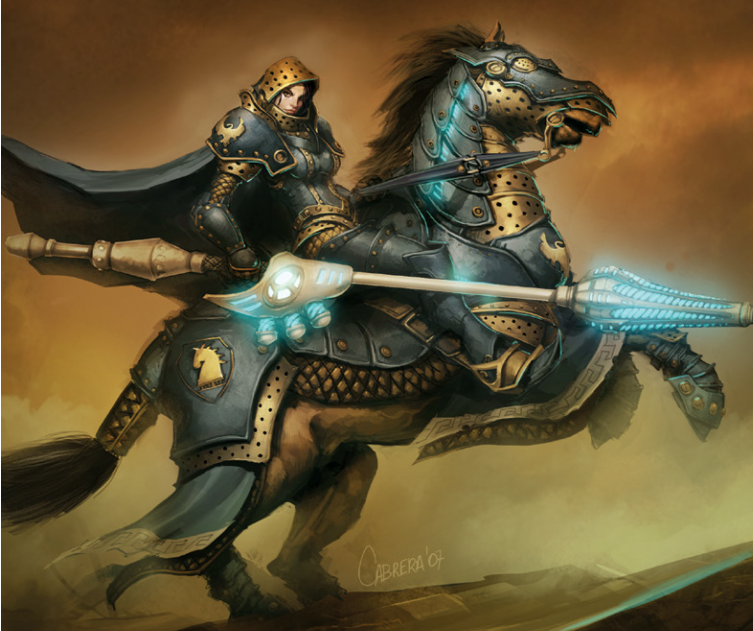
First of all, she's going to be a Human .
Her initial stat spread is the following:
- PHY 5
SPD 6
STR 4
- AGL 3
PRW 4
POI 4
- INT 3
ARC *
PER 3
We get three points to spend in any of those categories, plus a fourth one for any of the Big Three. We want her to be a frontline soldier, so we will improve her melee accuracy and damage, as well as her toughness.
Her new stat spread is the following (changes in bold):
- PHY 6
SPD 6
STR 5
- AGL 3
PRW 6
POI 4
- INT 3
ARC *
PER 3
PRW 6 is a really good score - she's at "this guy's a trained soldier" level. Her speed is pretty nice, and her STR is at a nice place right now. We don't really care about the other stuff right now.
Let's say she's from Cygnar, with some experience from serving in Llael. She speaks Caspian and Llaelese.
Now, we choose Mighty as her archetype. She will be rolling 3d6 on every melee attack roll, and 4d6 on a charge. I'm going to go with a thematic benefit - this character thinks swift offense is the best defense. And personally I love the idea of charging so hard you break someone's equipment.
I'm going to pick Feat: Shield Breaker , allowing me to spend a feat point whenever I hit someone to destroy their shield permanently. Since it's part of my ATTACK, it means I don't have to deal with the ARM bonus granted by a shield when I roll damage.
Alright, time for the careers.
Stormblade and Highwayman were the thread's choice, but I decided to swap the latter for something more fitting for our concept, the the Horseman . I'm going to contrast both of these careers to showcase my reasons though! There's IS a pseudo-career named the Storm Lance that was introduced in Kings, Nations and Gods, but it replaces the Stormblade/Knight combination, while granting you an Electro Lance and a Warhorse with Storm Barding, but replacing both of the Knight's starting abilities and the Storm Glaive. But that's neither here or there. Since technically the Horseman wasn't around when the Stormblade was released, it's an illegal combination, but it's pretty fitting (both are military careers, Storm Lances exist, and the Horseman isn't nation restricted) so who cares.
First of all, let's see what Stormblade gets us.
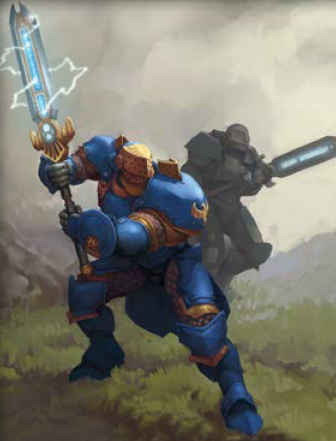
Stormblade posted:
Starting Abilities: Blaster and Specialization: Storm Glaive
Connections: Cygnarian Military
Military Skills: Great Weapon 1
Occupational Skills: Command 1, Detection 1, Etiquette 1
Starting Assets: Storm Glaive and Storm Knight Armor
Abilities are like feats - they can active or passive depending on the ability itself. Blaster means the character gets a +2 to his ranged attack rolls with electrical ranged attacks. Specialization is an ability that you can take more than once, and allows the character to ignore attack penalties on a weapon it wields. Such as the Storm Glaive - I mean, we're talking about a bastard sword with an integrated electric generator that can shoot out lightning. That must be quite difficult to handle.
Connections "are resources, not answers", as the rulebook puts it. There are no hard or fast rules when it comes to using Connections, they are just a way to remind you "Hey, this character belongs/used to belong to this organization. If you're willing to deal with the consequences, you can ask for help here". They are a roleplaying aid mostly - maybe this character left the Cygnarian army in bad terms, or she's still with them, or she only knows a couple of low ranking officers but they are fiercely loyal to her for some reason.
Military Skills are weapon related skills. They increase separately from Occupational Skills - no having to decide between being good at combat or social/exploration stuff. Great Weapon 1 means this character knows how to use stuff like claymores, zweihanders, bastard swords, halberds, pikes, etc. That 1 can go all the way up to 4, which is the maximum bonus achievable in a skill. You add it to your PRW whenever you roll an attack roll.
Occupational Skills are the non-combat related ones. Our character knows how to Command people, how to deal with social situations that involve nobles and it's perceptive enough to be good at Detection. Even though they aren't listed, she can learn other skills - General ones (available to all characters) and Medicine. We will see why in a bit.
She starts with a Storm Glaive and Storm Knight Armor. The latter is insulated in a such a way as to protect the user from the former.
An Storm Glaive is a hilariously expensive weapon (1,560gc) that can be wielded in one or two hands. Wielding it either way carries a penalty (1h: -2; 2h: -1) to attack rolls (which our character ignores for having Specialization). Wielding it in one hand means it's a POW 5 weapon, it becomes a POW 7 weapon if you wield it two-handed. This mean she'll be hitting for 4d6 + 12 on a charge attack while wielding her Storm Glaive in two hands.

The weapon also includes a Storm Chamber (which powers the weapon and will hit you harder than a rifle if you touch it without appropiate protection) and four rune points. Rune points are basically customization slots - and they can get pretty crazy. You could go for a boring (but effective. Remember, 2d6!) +1 to hit rune, or you could go for a rune that allows you to dispel any spells on a target when you hit it, or make it so enemies get frozen/lit on fire/slammed into their friends whenever you crit (which is as simple as rolling doubles on any dice).
As if all this wasn't enough, the Storm Glaive allows you to shoot lightning. It's a RNG 4, AOE - POW 12 ranged attack that causes Electrical damage. It uses POI, so our character should ignore this outside of "fuck, can't reach that guy quite yet" situations considering how poor a shot she is. You also suffer a POW 12 autohit whenever you use the Storm Glaive, that's what the armor is for!
The Storm Knight Armor is heavy as hell. You get -2 to SPD, -3 to DEF and +9 to ARM. There's a talent the Stormblade can get that will reduce this to -1 SPD and -2 DEF, but it's still a pretty hefty disadvantage, especially at lower levels. It's kind of expensive (225gc) and grants you the Immunity: Electricity ability. This is really nice for one particular reason - you see, Electricity is the only elemental effect (the others are Fire, Acid and Cold) that doesn't have a "continuous" effect (in the case of Fire and Acid) or an effect that will affect your turns (like Cold). Instead, electricity attacks tend to bounce around nearby enemies - and allies. If an attack specifies "Electricity" as its damage type, that's it - you are completely immune to it no matter how hard it hits.
----------------------------
Alright, that's quite a bit. But there's more - careers also have a secondary box that will tell you about what else you can get from a career. For example, a Stormblade can learn the Medicine skill (and all general skills), and the following abilities: 'Jack Marshal (allowing him to command a warjack without the need to be a Warcaster), Load Bearing (reduces armor speed and defense penalties), Quick Work (allows him to shoot as soon as he kills an enemy in melee) and Relentless Charge (gives the middle finger to any terrain between himself and the charge target). This last talent is pretty important, since you cannot charge over rough terrain - unless you can ignore it.
On the bad side, he can only improve his Great Weapon wielding skills, while only Command and General Skills can be improved all the way to 4 - Etiquette and Medicine are stuck at 2. The Stormblade is a through-and-through combat career in every sense of the word.
Now, let's see what we get from Horseman .
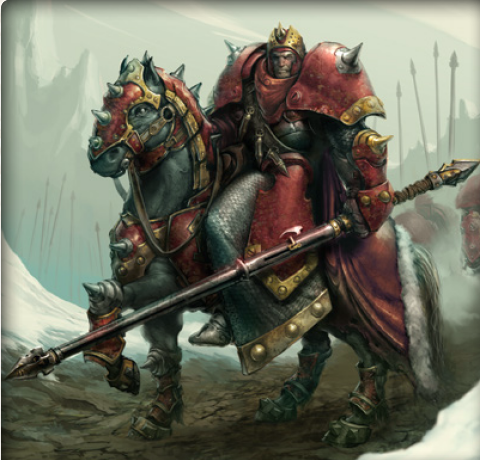
Horseman posted:
Starting Abilities: Cavalry Charge and Combat Rider.
Military Skills: Choose three - Great Weapon 1, Hand Weapon 1, Lance 1 or Pistol 1 (we don't pick this one).
Occupational Skills: Riding 1
Starting assets: 25gc, warhorse with tack and heavy barding.
Besides all that, a Horseman can learn Navigation, and some other ride-dependant abilities such as Counter Charge or Saddle Shot.
Combat Rider allows your mount to make an attack if you didn't charge this turn against someone in range, while Cavalry Charge allows you to do cavalry charges.
Mounted combat is slightly complex. In summary, your character gets a DEF penalty (which can be reduced till it disappears at Riding 4), while being hit becomes a dice roll to determine whether you or your mount got hit. Your mount can make impact attacks against people you touch during your cavalry charges, whie allowing you to make ride-by attacks (where you don't stop to hit someone as you go by) and ignoring people when determining line of sight because you're tall on the saddle. There are also rules for getting knocked out of your horse but that doesn't matter.
The warhorse is pretty tough, at 12 ARM and 12 Vitality points, while pretty fast at 8' on a normal advance. His impacts attack are at POW10, almost as hard as getting shot at by a bow or a pistol. The heavy barding makes the warhorse's ARM 20. The tack allows us to ignore the -3 to Riding penalty for trying to ride without a tack (you need to make Riding checks to do horse maneuvers).
Our Highwaywoman would have gotten Saddle Shot and Ambush, while only being able to use Hand Weapons and bows, crossbows or pistols. She'd have gotten a riding horse instead of a war horse, but hey, free mask. She'd also have Animal Handling, Detection, Intimidation and Riding all at 1. Riding horses are faster, but can't equip heavy barding. Yeah, we only start with 25g rather than 75g if we had chosen Highwaywoman, but you shouldn't forget that all our free gear is already over 2000g and counting. Combat characters are combat characters from the get go.
Anyways, that's careers. Our total abilities, skills and assets are looking like this:
quote:
Abilities: Blaster, Specialization (Storm Glaive), Combat Rider, Cavalry Charge
Military Skills: Great Weapon 2, Lance 1, Hand Weapon 1
Occupational Skills: Riding 1, Command 1, Etiquette 1, Detection 1
Connections: Cygnarian Military
Assets: 75g, Storm Glaive, Storm Knight Armor, Warhorse with Heavy Barding and Tack
Our life spiral, since we have PHY 6, AGL 3 and INT 3 is looking like this:
code:
[P] [A] [I]
[P] [A] [I]
[P][P] [A] [I]
[P][P]Crippled Physique: -2 STR
Crippled Agility: -2 to attack rolls
Crippled Intellect: -2 DEF. Can't upkeep spells.
You also roll to determine damage location in Warjacks, but it's more important there since you can destroy system pieces as to incapacitate their arms, legs, cortex, etc.
Regaining vitality is slow, a short rest after an encounter will give you vitality points back up to your PHY. I'm going to admit that I just don't like the simulation aspect of this game at times. I mean, look at this:
quote:
A character recoves 1 vitality point per hour for the first three hours after being injured. After that he regains 1 Vitality point per every six hours.

Anyways! We will spend those 75g in some loot. We've already got armor, a weapon and a heavily protected horse (the horse should be safe from our storm glaive, it would look different if it were a Storm Lance though). We also start with our clothes. I'm going to buy a Spear for mounted combat (15g) -
quote:
Spear
POW 4/5 (1h/2h).
Has Reach (2' engagement range instead of 0.5') whenever you hold it in two hands.
You get +2 to charge attack rolls.
It's a Great Weapon and you get a -1 attack modifier with it (which should be compensated by the charge attack roll bonus).
I could buy something reasonable, like a pistol, or something silly, like a gun shield but I'm going to get an equestrian gas mask for 45g. That will make my horse immune to gas effects and it has +1 ARM against corrosion damage, while suffering some minor penalties to his senses. I will spend my remaining 10g in some Metro 2033 flashbacks by buying two spare filters.
quote:
Abilities: Blaster, Specialization (Storm Glaive), Combat Rider, Cavalry Charge
Military Skills: Great Weapon 2, Lance 1, Hand Weapon 1
Occupational Skills: Riding 1, Command 1, Etiquette 1, Detection 1
Connections: Cygnarian Military
Assets: Spear, Storm Glaive, Storm Knight Armor, Warhorse with Heavy Barding, Tack and Equestrian Gas Mask with two spare filters
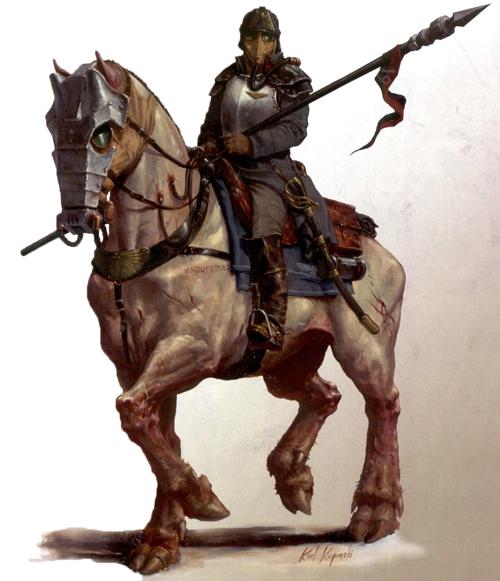
Yesssss.
It's important to note that our Great Weapon skill is at 2. That's the highest it will go till we reach the Veteran tier, where it will be able to go to 3. And then it will go to 4 in the Epic Tier, if we choose to improve it.
Our derived stats are the following:
Defense: 6 (SPD) + 6 (PRW) + 3 (PER) - 3 (for being on top of a horse with Riding 1) and -3 (Storm Knight Armor) = DEF 9 while mounted, DEF 12 while on foot. We're also moving at 4' on foot, and 8' mounted.
Armor: 6 (PHY) + 9 (Storm Knight Armor) = ARM 15. The horse has ARM 20.
Willpower: 6 (PHY) + 3 (INT) = WIL 9.
Initiative: 6 (SPD) + 6 (PRW) + 3 (PER) = I 15
Our Melee Attack Rating (MAT) with the Storm Glaive is 8 (PRW 6 + Great Weapon 2), so we will roll 2d6 + 8 whenever we roll to hit. Our Power + Strength (P+S) is 10/12 if one-handing/two-handing it.
Our MAT with the Spear is 7 (PRW 6 + Great Weapon 2 - 1 for its attack penalty), but becomes MAT 9 during a charge. The Spear's P+S is 9/10 (1h/2h)
Our Ranged Attack Rating (RAT) with the Storm Glaive's gun is 4 (POI 4). Since it's a non-throwing ranged weapon, it's Power is stuck at 12 - it doesn't get our STR added to it.
And that's it, really.
Next time, the Gobber and advancement rules!
As an aside, I will also admit that this system needs a little less crunch. A simplified math would go a long way to keep it closer to the wargame and its elegant system.